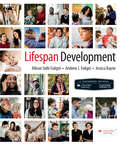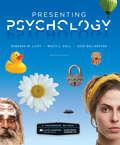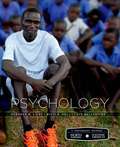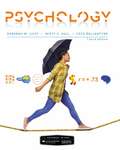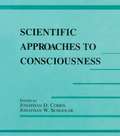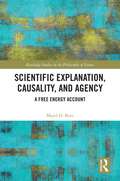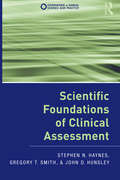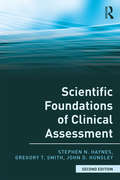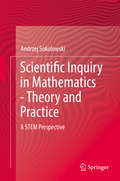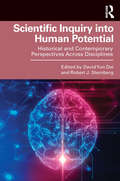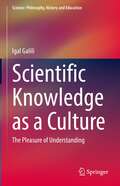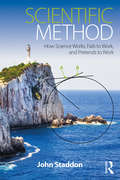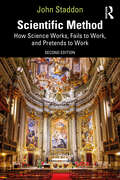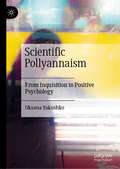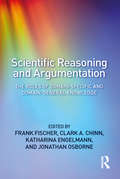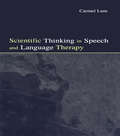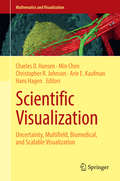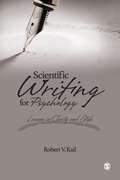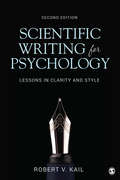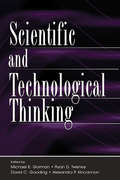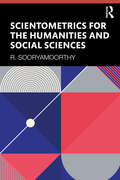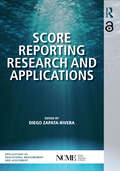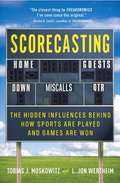- Table View
- List View
Scientific American: Lifespan Development
by Andrew J. Fuligni Jessica Bayne Allison Sidle FuligniA journey through the current landscape of lifespan development through a series of Scientific American-style profiles of some extraordinary individuals.
Scientific American: Presenting Psychology
by Deborah Licht Misty Hull Coco BallantyneIn this breakthrough student resource, two committed, tech-savvy professors, Deborah Licht and Misty Hull, combine years of research and teaching insights with the journalistic skill of science writer, Coco Ballantyne, who came to the project directly from Scientific American. Together, they have created an introductory psychology textbook and online learning and comprehension system that draws on written profiles and video interviews of 26 real people to help students better understand, remember, apply, and relate to psychology’s foundational concepts and ideas. Beautifully designed, the printed text is filled with high-interest examples and features, including full-page infographics that help students understand and retain key concepts. Online, additional author-created resources, including scaffolded activities and adaptive quizzes, provide a seamless learning experience for students and a reliable assessment mechanism for instructors and programs. This innovative collaboration between Worth Publishers and Scientific American reflects a commitment to engaging and educating all students, including those who sometimes seem difficult to engage—in the contemporary style of the world’s most respected science magazine. Along with student engagement with the personal stories, Presenting Psychology 2e also aims to: Demonstrate that psychology is a science Help students see the “big picture” Provide high-quality accessible visuals that make a difference! Illustrate real-world applications Maintain a positive perspective of psychology Emphasize gender and cultural diversity Help dispel myths Provide quality assessments Create interactive, technology-based learning that appeals to students
Scientific American: Psychology
by Deborah Licht Misty Hull Coco BallantyneIn this breakthrough introduction to psychology, two committed, tech-savvy professors, Deborah Licht and Misty Hull, combine years of research and teaching insights with the journalistic skill of science writer, Coco Ballantyne, who came to this project directly from Scientific American. Together, they have created a an introductory textbook and online system that draws on written profiles and video interviews of 27 real people to help students better understand, remember, and relate to psychology's basic ideas. Beautifully designed, the printed text is filled with high-interest examples and features, including full-page infographics that help students understand and retain key concepts. Online, additional author-created resources, including scaffolded activities and adaptive quizzes, provide a seamless learning experience for students and a reliable assessment mechanism for instructors and programs. This innovative collaboration between Worth Publishers and Scientific American reflects a commitment to engaging and educating all students, including those who sometimes seem difficult to engage--in the contemporary style of the world's most respected science magazine. What's in the LaunchPad
Scientific American: Psychology
by Deborah Licht Misty Hull Coco BallantyneIn this breakthrough student resource, two committed, tech-savvy professors, Deborah Licht and Misty Hull, combine years of research and teaching insights with the journalistic skill of science writer, Coco Ballantyne, who came to the project directly from Scientific American. Together, they have created an introductory psychology textbook and online learning and comprehension system that draws on written profiles and video interviews of real people and their stories to help students better understand and relate to psychology's foundational concepts and ideas as well as solutions for the 10 challenges that face both students and instructors in the introductory course today. Beginning with addressing the top 10 Challenges facing instructors (creating relevance, student engagement, seeing psychology as a science, teaching the hardest concepts, and dispelling myths) and students (students see the big picture, learning the toughest concepts, seeing the connections between life and psychology, relevancy to the real world, and diversity) in the Preface, Scientific American: Psychology 3e is filled with high-interest examples and features, including full-page infographics that help students understand and retain key concepts. With a renewed emphasis on research methods in a brand new stand-alone Chapter 2 (Research Methods), this innovative collaboration between Worth Publishers and Scientific American reflects a commitment to engaging and educating all students, including those who sometimes seem difficult to engage - in the contemporary style of the world's most respected science magazine.
Scientific Approaches to Consciousness (Carnegie Mellon Symposia on Cognition Series)
by Jonathan W. Schooler Jonathan D. CohenThere are many ways to approach the understanding of consciousness. Questions about these ways have occupied philosophers and metaphysicians for centuries. During the early growth of cognitive science the problem of consciousness remained taboo, but an increasing number of studies have either implicitly or explicitly begun to bear on its nature. These have been inspired by a number of different different original questions, and focus on a variety of different empirical phenomena. Thus, studies of implicit memory, subliminal processing, strategic versus automatic processing, allocation of attention, and differences between information processes in the awake versus dreaming state all share a common assumption of a particular quality or state -- awakeness, awareness, alertness, namely consciousness -- that somehow can be distinguished from another type of state or states in which the subject is not aware of the information being processed. What distinguishes the cognitive psychological and cognitive neuroscience approach to the question of consciousness from that of philosophy and metaphysics is scientific methodology: a set of tools that permit the empirical study of a phenomenon in an objective and reproducible way. Recent developments in both the empirical and theoretical methodologies of these fields have made it possible to begin to study the phenomenon associated with -- if not directly underlying -- consciousness in a scientific fashion. This volume tries to resolve the difficulties associated with the scientific investigation of consciousness. The intent is to explore the extent to which consciousness can be the target of direct scientific inquiry, to get on the table some of the relevant work, and consider the degree to which this research can help inform our understanding of consciousness. It brings together a group of cognitive and neuroscientists to share relevant recent research in the fields of cognitive science and neuroscience and to determine whether any new strategies for the scientific pursuit of this question can be developed. A long-term goal is the development of a unified understanding of consciousness, scientific as well as philosophical perspectives. This volume takes the first step toward building the necessary local bridges.
Scientific Explanation, Causality, and Agency: A Free Energy Account (Routledge Studies in the Philosophy of Science)
by Majid D. BeniThis book draws on advances in computational neuroscience and theoretical biology to provide a clear and accessible agentive account of the nature of causality and scientific explanations.Instead of attempting to establish the elements of scientific explanation, such as causality, in a reality unadulterated by a human perspective, this book relies on scientific facts about cognition to describe the structure of agency from a distinctly human perspective. The book draws on the Free Energy Principle to reinforce the agency theory of causality and extend it to an account of explanation as well. This principle not only provides a theoretical account of how self-organising systems engage with the causal structure of the environment, but it also offers a viable notion of agency and is compatible with the projectivist aspects of the agency theory.Scientific Explanation, Causality, and Agency will appeal to researchers and advanced students working in philosophy of science, philosophy of cognitive science, epistemology, computational neuroscience, and theoretical biology.
Scientific Foundations of Clinical Assessment (Foundations of Clinical Science and Practice)
by Stephen N. Haynes Gregory T. Smith John D. HunsleyScientific Foundations of Clinical Assessment is a user-friendly overview of the most important principles and concepts of clinical assessment. It provides readers with a science-based framework for interpreting assessment research and making good assessment decisions, such as selecting the best instruments and measures and interpreting the obtained assessment data. Written in a direct and highly readable fashion, with plenty of clinical examples that illustrate the relevance of psychometric principles and assessment research, this text is one every professional and graduate student needs to read. Numerous elements are used consistently throughout the book to facilitate understanding and retention, such as: • text boxes that provide extended presentations of the application of principles and research• end-of-chapter summaries that review key issues covered, and• additional recommended sources for each chapter. A detailed glossary that defines key measurement and assessment concepts is also included, making this book an invaluable reference and supplementary text for anyone who does clinical assessment in the health and mental health domains.
Scientific Foundations of Clinical Assessment (Foundations of Clinical Science and Practice)
by Stephen N. Haynes Gregory T. Smith John D. HunsleyScientific Foundations of Clinical Assessment is a user-friendly overview of the most important principles and concepts of clinical assessment. It provides readers with a science-based framework for interpreting assessment research and making good assessment decisions, such as selecting the best instruments and measures and interpreting the obtained assessment data. Written in a direct and highly readable fashion, with plenty of clinical examples that illustrate the relevance of psychometric principles and assessment research, this text is one every professional and graduate student needs to read. The second edition is expanded and fully updated, and includes additional coverage of the principles and methods of developing new assessment instruments.
Scientific Inquiry in Mathematics - Theory and Practice: A Stem Perspective
by Andrzej SokolowskiThis valuable resource provides an overview of recent research and strategies in developing and applying modelling to promote practice-based research in STEM education. In doing so, it bridges barriers across academic disciplines by suggesting activities that promote integration of qualitative science concepts with the tools of mathematics and engineering. The volume’s three parts offer a comprehensive review, by 1) Presenting a conceptual background of how scientific inquiry can be induced in mathematics classes considering recommendations of prior research, 2) Collecting case studies that were designed using scientific inquiry process designed for math classes, and 3) Exploring future possibilities and directions for the research included within. Among the topics discussed: · STEM education: A platform for multidisciplinary learning. · Teaching and learning representations in STEM. · Formulating conceptual framework for multidisciplinary STEM modeling. · Exploring function continuity in context. · Exploring function transformations using a dynamic system. Scientific Inquiry in Mathematics - Theory and Practice delivers hands-on and concrete strategies for effective STEM teaching in practice to educators within the fields of mathematics, science, and technology. It will be of interest to practicing and future mathematics teachers at all levels, as well as teacher educators, mathematics education researchers, and undergraduate and graduate mathematics students interested in research based methods for integrating inquiry-based learning into STEM classrooms.
Scientific Inquiry into Human Potential: Historical and Contemporary Perspectives Across Disciplines
by David Yun Dai and Robert J. SternbergScientific Inquiry into Human Potential explores the intellectual legacy and contemporary understanding of scientific research on human intelligence, performance, and productivity. Across nineteen chapters, some of the most eminent scholars of learning and psychology recount how they originated, distinguished, measured, challenged, and adapted their theories on the nature and nurture of human potential over decades of scientific research. These accessible, autobiographical accounts cover a spectrum of issues, from the biological underpinnings and developmental nature of human potential to the roles of community, social interaction, and systematic individual differences in cognitive and motivational functioning. Researchers, instructors, and graduate students of education, psychology, sociology, and biology will find this book not only historically informative but inspiring to their own ongoing research journeys, as well.
Scientific Knowledge as a Culture: The Pleasure of Understanding (Science: Philosophy, History and Education)
by Igal GaliliThis book, in its first part, contains units of conceptual history of several topics of physics based on the research in physics education and research based articles with regard to several topics involved in teaching science in general and physics in particular. The second part of the book includes the framework used, the approach considering science knowledge as a special type of culture – discipline-culture. Within this approach, scientific knowledge is considered as comprised of a few inclusive fundamental theories each hierarchically structured in a triadic pattern: nucleus-body-periphery. While nucleus incorporates the basic principles and body comprises their implementations in the variety of laws, models, and experiments, periphery includes concepts at odds to the nucleus. This structure introduces knowledge in its conceptual variation thus converting disciplinary knowledge to cultural-disciplinary one. The approach draws on history and philosophy of science (HPS) necessary for meaningful learning of science. It is exemplified in several aspects regarding teaching physics, presenting history in classes, considering the special nature of science, and using artistic images in regular teaching. The revealed conceptual debate around the chosen topics clarifies the subject matter for school students and teachers encouraging construction of Cultural Content Knowledge. Often missed in teachers' preparation and common curriculum it helps genuine understanding of science thus providing remedy of students' misconceptions reported in educational research.
Scientific Method: How Science Works, Fails to Work, and Pretends to Work
by John StaddonThis book shows how science works, fails to work, or pretends to work, by looking at examples from such diverse fields as physics, biomedicine, psychology, and economics. Social science affects our lives every day through the predictions of experts and the rules and regulations they devise. Sciences like economics, sociology and health are subject to more ‘operating limitations’ than classical fields like physics or chemistry or biology. Yet, their methods and results must also be judged according to the same scientific standards. Every literate citizen should understand these standards and be able to tell the difference between good science and bad. Scientific Method enables readers to develop a critical, informed view of scientific practice by discussing concrete examples of how real scientists have approached the problems of their fields. It is ideal for students and professionals trying to make sense of the role of science in society, and of the meaning, value, and limitations of scientific methodology in the social sciences.
Scientific Method: How Science Works, Fails to Work, and Pretends to Work
by John StaddonThis expanded second edition of Scientific Method shows how science works, fails to work or pretends to work by looking at examples from physics, biomedicine, psychology, sociology and economics.Scientific Method aims to help curious readers understand the idea of science, not by learning a list of techniques but through examples both historical and contemporary. Staddon affirms that if the reader can understand successful studies as well as studies that appear to be scientific but are not, they will become a better judge of the “science” in circulation today. To this end, this new edition includes a new chapter, What is Science?, which points out that science, like any human activity, has its own set of values, with truth being the core. Other new chapters focus on the emergence of AI and machine learning, science and diversity, and behavioral economics. The book also includes textual features such as bullet-points and text boxes on topical issues.Scientific Method is essential reading for students and professionals trying to make sense of the role of science in society, and of the meaning, value and limitations of scientific methodology.
Scientific Pollyannaism: From Inquisition to Positive Psychology
by Oksana YakushkoThis book argues that the story of the orphan girl Pollyanna (namely, her strategy of playing the “glad games” to manage loss, abuse, and social prejudice) serves as a framework for critiquing historical forms of Western scientific Pollyannaism. The author examines Pollyannaism as it relates to the sciences, demonstrating how the approach has been used throughout modern Western history to enforce happiness and to criticize negative human emotional states. These efforts, carried out by scientists and popularized as scientific, focus on negating the role of the environment and on promoting varied forms of emotional control. Ultimately, the book emphasizes strategies used to compel individuals into becoming Pollyannas about science itself.
Scientific Reasoning and Argumentation: The Roles of Domain-Specific and Domain-General Knowledge
by Frank Fischer Jonathan Osborne Clark A. Chinn Katharina EngelmannCompetence in scientific reasoning is one of the most valued outcomes of secondary and higher education. However, there is a need for a deeper understanding of and further research into the roles of domain-general and domain-specific knowledge in such reasoning. This book explores the functions and limitations of domain-general conceptions of reasoning and argumentation, the substantial differences that exist between the disciplines, and the role of domain-specific knowledge and epistemologies. Featuring chapters and commentaries by widely cited experts in the learning sciences, educational psychology, science education, history education, and cognitive science, Scientific Reasoning and Argumentation presents new perspectives on a decades-long debate about the role of domain-specific knowledge and its contribution to the development of more general reasoning abilities.
Scientific Thinking in Speech and Language Therapy
by Carmel LumSpeech and language pathologists, like all professionals who claim to be scientific in their practice, make a public commitment to operate on the basis of knowledge derived in accordance with sound scientific standards. Yet students in communication disorders are given relatively little grounding in the fundamentals of science; indeed, they often receive implicit encouragement to rely on clinical wisdom. This pathbreaking text introduces the principles of critical scientific thinking as they relate to assessing communication problems, deciding about alternative approaches to intervention, and evaluating outcomes. The author provides many illustrative examples to help readers contextualize the ideas. Her clear presentation will help not only undergraduate and graduate students but also established professionals reason more effectively about what they are doing and why. Though the examples come from speech and language pathology, this illuminating and readable book constitutes a valuable resource for all clinical practitioners.
Scientific Visualization
by Hans Hagen Min Chen Charles D. Hansen Christopher R. Johnson Arie E. KaufmanBased on the seminar that took place in Dagstuhl, Germany in June 2011, this contributed volume studies the four important topics within the scientific visualization field: uncertainty visualization, multifield visualization, biomedical visualization and scalable visualization. * Uncertainty visualization deals with uncertain data from simulations or sampled data, uncertainty due to the mathematical processes operating on the data, and uncertainty in the visual representation, * Multifield visualization addresses the need to depict multiple data at individual locations and the combination of multiple datasets, * Biomedical is a vast field with select subtopics addressed from scanning methodologies to structural applications to biological applications, * Scalability in scientific visualization is critical as data grows and computational devices range from hand-held mobile devices to exascale computational platforms. Scientific Visualization will be useful to practitioners of scientific visualization, students interested in both overview and advanced topics, and those interested in knowing more about the visualization process.
Scientific Writing for Psychology: Lessons in Clarity and Style
by Robert V. KailScientific Writing for Psychology: Lessons in Clarity and Style provides straightforward, hands-on strategies to help psychology students master scientific writing. At the core of this brief and engaging guide are seven class-tested lessons: three devoted to sentences, one to paragraphs, and three to writing research reports. Packed with helpful examples and an abundance of writing wisdom, this book addresses the skills every successful writer needs.
Scientific Writing for Psychology: Lessons in Clarity and Style
by Robert V. KailIn the Second Edition of Scientific Writing for Psychology, veteran teacher, editor and author, Robert V. Kail provides straightforward strategies along with hands-on exercises for effective scientific writing in a series of seven lessons. Kail shares an abundance of writing wisdom with “tools of the trade”—heuristics, tips, and strategies—used by expert authors to produce writing that is clear, concise, cohesive, and compelling. The exercises included throughout each extensively class-tested lesson allow students to practice and ultimately master their scientific writing skills.
Scientific Writing for Psychology: Lessons in Clarity and Style
by Robert V. KailIn the Second Edition of Scientific Writing for Psychology, veteran teacher, editor and author, Robert V. Kail provides straightforward strategies along with hands-on exercises for effective scientific writing in a series of seven lessons. Kail shares an abundance of writing wisdom with “tools of the trade”—heuristics, tips, and strategies—used by expert authors to produce writing that is clear, concise, cohesive, and compelling. The exercises included throughout each extensively class-tested lesson allow students to practice and ultimately master their scientific writing skills.
Scientific and Technological Thinking
by Michael E. Gorman Ryan D. Tweney David C. Gooding Alexandra P. KincannonAt the turn of the 21st century, the most valuable commodity in society is knowledge--particularly new knowledge that may give a culture, company, or laboratory an adaptive advantage. Knowledge about the cognitive processes that lead to discovery and invention can enhance the probability of making valuable new discoveries and inventions. Such knowledge needs to be made widely available to ensure that no particular interest group "corners the market" on techno-scientific creativity. Knowledge can also facilitate the development of business strategies and social policies based on a genuine understanding of the creative process. Furthermore, through an understanding of principles underlying the cognitive processes related to discovery, educators can utilize these principles to teach students effective problem-solving strategies as part of their education as future scientists.This book takes the reader out onto the cutting edge of research in scientific and technological thinking. The editors advocate a multiple-method approach; chapters include detailed case studies of contemporary and historical practices, experiments, computational simulations, and innovative theoretical analyses. The editors attempt a provocative synthesis of this work at the end.In order to achieve true scientific and technological progress, an understanding of the process by which species are transforming the world is needed. This book makes an important step in that direction by leading to breakthroughs in the understanding of discovery and invention.
Scientists Making a Difference
by Robert J. Sternberg Susan T. Fiske Sternberg, Robert J. and Fiske, Susan T. and Foss, Donald J. Donald J. FossScientists Making a Difference is a fascinating collection of first-person narratives from the top psychological scientists of the modern era. These readable essays highlight the most important contributions to theory and research in psychological science, show how the greatest psychological scientists formulate and think about their work, and illustrate how their ideas develop over time. In particular, the authors address what they consider their most important scientific contribution, how they got the idea, how the idea matters for the world beyond academic psychology, and what they would like to see as the next steps in research. The contributors, who were chosen from an objectively compiled list of the most eminent psychological scientists, provide a broad range of insightful perspectives. This book is essential reading for students, researchers and professionals interested in learning about the development of the biggest ideas in modern psychological science, described firsthand by the scientists themselves.
Scientometrics for the Humanities and Social Sciences
by R. SooryamoorthyScientometrics for the Humanities and Social Sciences is the first ever book on scientometrics that deals with the historical development of both quantitative and qualitative data analysis in scientometric studies. It focuses on its applicability in new and emerging areas of inquiry. This important book presents the inherent potential for data mining and analysis of qualitative data in scientometrics. The author provides select cases of scientometric studies in the humanities and social sciences, explaining their research objectives, sources of data and methodologies. It illustrates how data can be gathered not only from prominent online databases and repositories, but also from journals that are not stored in these databases. With the support of specific examples, the book shows how data on demographic variables can be collected to supplement scientometric data. The book deals with a research methodology which has an increasing applicability not only to the study of science, but also to the study of the disciplines in the humanities and social sciences.
Score Reporting Research and Applications
by Diego Zapata-RiveraScore reporting research is no longer limited to the psychometric properties of scores and subscores. Today, it encompasses design and evaluation for particular audiences, appropriate use of assessment outcomes, the utility and cognitive affordances of graphical representations, interactive report systems, and more. By studying how audiences understand the intended messages conveyed by score reports, researchers and industry professionals can develop more effective mechanisms for interpreting and using assessment data. Score Reporting Research and Applications brings together experts who design and evaluate score reports in both K-12 and higher education contexts and who conduct foundational research in related areas. The first section covers foundational validity issues in the use and interpretation of test scores; design principles drawn from related areas including cognitive science, human-computer interaction, and data visualization; and research on presenting specific types of assessment information to various audiences. The second section presents real-world applications of score report design and evaluation and of the presentation of assessment information. Across ten chapters, this volume offers a comprehensive overview of new techniques and possibilities in score reporting.
Scorecasting: The Hidden Influences Behind How Sports Are Played and Games Are Won
by L. Jon Wertheim Tobias J. MoskowitzMoskowitz, a University of Chicago behavioral economist, teams up with veteran "Sports Illustrated" writer Wertheim to look at the hidden influences and subtle biases that shape and sway sports behavior and outcomes.
